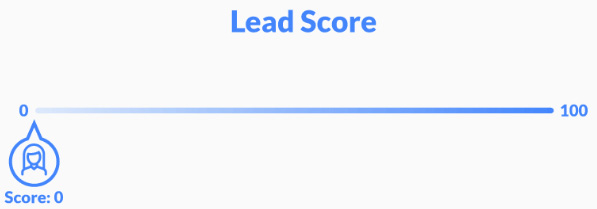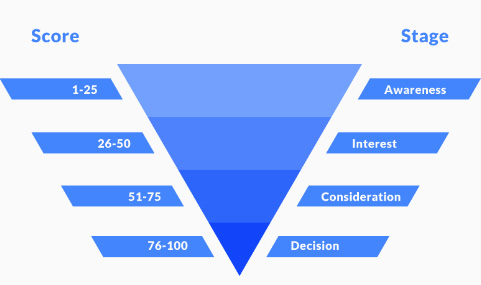
Introduction
What’s the most important thing for a business owner?
It is to be able to generate leads, engage prospects, and convert them into buying customers to grow your business.
But everyone knows that not all leads are created equal. Some of them may be genuinely interested in buying your product or services while others may be just looking around.
That’s where lead scoring comes into the picture.
With lead scoring, you can rate, rank, and prioritize sales leads based on their chances of converting into actual purchases.
This will help you ensure that you don’t waste your time, money, and resources on engaging prospects who have little or no chances of driving conversions. At the same time, you’ll not ignore people who are on the edge of converting into paying customers.
But for this to happen, you will have to put a lead scoring system in place.
Before I tell you more about it, let’s take a closer look at what lead scoring is and what makes it so important for your business. Then, I’ll also help you understand how to set up a lead scoring model for your business.
What Is Lead Scoring?
Lead scoring is a popular strategy used by marketing and sales teams to evaluate the effectiveness of your leads. This value determines how likely a particular prospect is to buy your product or service.
It quantifies how interested a lead is in your products or service on a scale of 0 to 100 points.

Image via Propeller CRM
But how will you assign lead scores to each of your prospects?
There are a number of ways to rate your leads based on a point range of 0 to 100, but every lead scoring model is different.
Different Types of Lead Scoring Models-
- Lead Scoring: Based on Demographics
- Lead Scoring: Based on Website Visitors’ Activities
- Lead Scoring: Based on Email Engagement
Let’s find out what factors you can consider to assign lead scores to your prospects. It will differ based on the data you collect about consumers who engage with your business.
Some of the possible options include:
Lead Scoring: Based on Demographics
Do you have a product or service that is relevant to a certain demographic only?
For example, your brand may sell newborn baby care products, which makes the parents of newborns and young kids your ideal buyers.
In this case, you can collect demographic information of your leads and give them points based on how well they fit into your target audience. Or, you can deduct points from prospects who do not fall under your target audience.
This will help you identify high-converting leads that are worth investing in.
Lead Scoring: Based on Website Visitors’ Activities
You can also create a lead scoring model to identify sales leads from people who visit your site. The scoring will depend on how they interact with your site.
For example, if you’re running an ecommerce business, you can rate your site visitors using the following lead scoring parameters:
| Action Taken by Website Visitor | Lead Score |
| Read a blog post | +3 points |
| Visit a product page | +10 points |
| Search for a specific product | +10 points |
| Add products to shopping cart | +20 points |
| Provide email in exchange for a discount | +5 points |
| PDF or white paper download | +2 points |
Lead Scoring: Based on Email Engagement
Another common method to generate leads is to run email campaigns. So, let’s find out how you can create a lead scoring model based on email engagement data.
You can easily rate the effectiveness and conversion chances of your prospects using metrics such as open rate, click-through rate, and the number of downloads (if you had shared any downloadable resource).
Here’s how an email engagement based lead scoring system may look like:
| Action Taken by Email Recipients | Lead Score |
| Open your email | +5 points |
| Click on the link in your email | +10 points |
| Sign up to attend your webinar | +20 points |
| Download a resource | +10 points |
| Provide email in exchange for a discount | +5 points |
| Not responding after more than 3 emails | -25 points |
These are just a few examples. There can be multiple other lead scoring models based on your business needs.
How Can You Set Up Lead Scoring for Each Stage of the Buyers’ Journey?
To create a lead scoring model for your business, you need to understand which characteristics of a prospect should increase their lead score. Similarly, you need to determine factors that should reduce the points assigned to a lead.
You should use factors related to both demographics and activity to assign lead scores to each of your prospects.
Here’s a flow chart you can follow to set up your lead scoring rules:
| Positive Lead Scoring (+) | Negative Lead Scoring (-) | |
| Demographics | Belongs to the right age group? Works in the right industry? Has the same interests as that of your ideal buyers? Company has enough employees and turn over to be your target audience? | Is younger or older than your target audience? Has a different job title? The company belongs to a different industry and may not need your products? |
| Activity | Visits the right pages on your site? Opened your email? Clicked on the discount offer? Downloaded a PDF report, case study, or white paper? | Doesn’t open your email? Prolonged inactivity on your site? Bounced away from your site within seconds? |
But how can you decide on how many points you should add or subtract from a lead’s score?
You should make this decision based on how much each action brings the lead closer to converting. Some demographics and actions can have a higher potential for conversions such as adding products to the cart.
Whereas, some actions may be subtle such as checking out a blog post. Such actions suggest that the prospect is just looking around for information about a topic, product, or service. They may or may not have an intention to buy something.
Activities that show a higher probability of driving a conversion should be given more positive points as compared to subtle actions.
Understanding the four stages of a buyer’s journey can help you assign lead scores more efficiently. You should be able to determine which stage is a prospect going through based on their activities and assign lead scores accordingly.

Image via Propeller CRM
Let’s take a look at a few activities and demographics that come under each stage of a buyer’s journey.
| The Stages of a Buyer’s Journey | Activity |
| Awareness | Followed you on social media? Read blog posts? Downloaded white paper? |
| Interest | Downloaded case study PDFs? Clicked on the link in the email? |
| Consideration | Checked out individual product pages? Compared two or more products or service packages? Read how-to guides? Watched product tutorials? |
| Decision | Added products to the cart? Checked for discount offers? Read testimonials? Checked customer ratings? |
Once you’ve assigned lead scores for every activity, it is time to test your lead scoring model. Remember, no model is perfect. You will have to test it and optimize it on the go.
Over time, you’ll be able to create a lead scoring model that helps you identify your best quality leads and enables you to close deals faster.
Ready to Score Your Business Leads?
When it comes to lead scoring, there is no one-size-fits-all approach. Each business is unique and so are its lead scoring model needs.
You should figure out which signals indicate a lead’s strong interest in buying your product or service. Then, you can assign higher lead scores for those activities and demographics.
You can also use sales tools to close deals with your top-scoring leads.
Do you have other questions about lead scoring and how to assign lead scores to every stage of user engagement? Leave them in the comments below. I’ll be happy to answer your questions and help you evaluate the quality of your leads.
Our blog
Latest blog posts
Tool and strategies modern teams need to help their companies grow.

Beat your competitors and exceed your revenue goals this year by shifting your focus ...

SaaS growth has never been more challenging. SaaS companies must move faster and smar...

In the absence of a solid lead scoring system, your sales team will spend time pursui...




